Reading time for children: 20 min
There was once a rich man whose wife lay sick, and when she felt her end drawing near she called to her only daughter to come near her bed, and said, „Dear child, be pious and good, and God will always take care of you, and I will look down upon you from heaven, and will be with you.“ And then she closed her eyes and expired. The maiden went every day to her mother’s grave and wept, and was always pious and good. When the winter came the snow covered the grave with a white covering, and when the sun came in the early spring and melted it away, the man took to himself another wife.
The new wife brought two daughters home with her, and they were beautiful and fair in appearance, but at heart were, black and ugly. And then began very evil times for the poor step-daughter. „Is the stupid creature to sit in the same room with us?“ said they. „Those who eat food must earn it. Out upon her for a kitchen-maid!“ They took away her pretty dresses, and put on her an old grey kirtle, and gave her wooden shoes to wear. „Just look now at the proud princess, how she is decked out!“ cried they laughing, and then they sent her into the kitchen.
There she was obliged to do heavy work from morning to night, get up early in the morning, draw water, make the fires, cook, and wash. Besides that, the sisters did their utmost to torment her, mocking her, and strewing peas and lentils among the ashes, and setting her to pick them up. In the evenings, when she was quite tired out with her hard day’s work, she had no bed to lie on, but was obliged to rest on the hearth among the cinders. And as she always looked dusty and dirty, they named her Cinderella.
It happened one day that the father went to the fair, and he asked his two step-daughters what he should bring back for them. „Fine clothes!“ said one. „Pearls and jewels!“ said the other. „But what will you have, Cinderella?“ said he. „The first twig, father, that strikes against your hat on the way home. That is what I should like you to bring me.“ So he bought for the two step-daughters fine clothes, pearls, and jewels, and on his way back, as he rode through a green lane, a hazel-twig struck against his hat; and he broke it off and carried it home with him.
And when he reached home he gave to the step-daughters what they had wished for, and to Cinderella he gave the hazel-twig. She thanked him, and went to her mother’s grave, and planted this twig there, weeping so bitterly that the tears fell upon it and watered it, and it flourished and became a fine tree. Cinderella went to see it three times a day, and wept and prayed, and each time a white bird rose up from the tree, and if she uttered any wish the bird brought her whatever she had wished for.
Now if came to pass that the king ordained a festival that should last for three days, and to which all the beautiful young women of that country were bidden, so that the king’s son might choose a bride from among them. When the two stepdaughters heard that they too were bidden to appear, they felt very pleased, and they called Cinderella, and said, „Comb our hair, brush our shoes, and make our buckles fast, we are going to the wedding feast at the king’s castle.“ Cinderella, when she heard this, could not help crying, for she too would have liked to go to the dance, and she begged her step-mother to allow her.
„What, you Cinderella!“ said she, „in all your dust and dirt, you want to go to the festival! you that have no dress and no shoes! you want to dance!“ But as she persisted in asking, at last the step-mother said, „I have strewed a dish-full of lentils in the ashes, and if you can pick them all up again in two hours you may go with us.“ Then the maiden went to the backdoor that led into the garden, and called out, „O gentle doves, O turtle-doves, And all the birds that be, The lentils that in ashes lie Come and pick up for me!
The good must be put in the dish. The bad you may eat if you wish.“
Then there came to the kitchen-window two white doves, and after them some turtle-doves, and at last a crowd of all the birds under heaven, chirping and fluttering, and they alighted among the ashes. And the doves nodded with their heads, and began to pick, peck, pick, peck, and then all the others began to pick, peck, pick, peck, and put all the good grains into the dish. Before an hour was over all was done, and they flew away. Then the maiden brought the dish to her step-mother, feeling joyful, and thinking that now she should go to the feast.
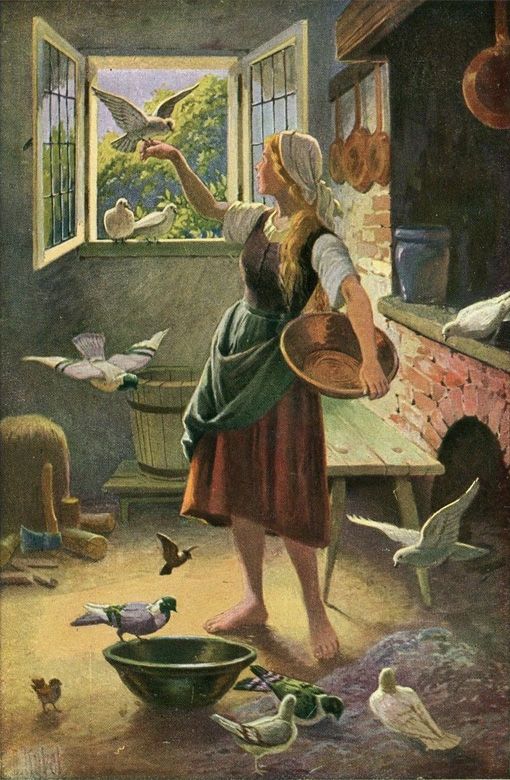 Image: Otto Kubel (1868 – 1951)
Image: Otto Kubel (1868 – 1951)But the step-mother said, „No, Cinderella, you have no proper clothes, and you do not know how to dance, and you would be laughed at!“ And when Cinderella cried for disappointment, she added, „If you can pick two dishes full of lentils out of the ashes, nice and clean, you shall go with us,“ thinking to herself, „for that is not possible.“ When she had strewed two dishes full of lentils among the ashes the maiden went through the backdoor into the garden, and cried, „O gentle doves, O turtle-doves, And all the birds that be, The lentils that in ashes lie Come and pick up for me!
The good must be put in the dish. The bad you may eat if you wish.“
So there came to the kitchen-window two white doves, and then some turtle-doves, and at last a crowd of all the other birds under heaven, chirping and fluttering, and they alighted among the ashes, and the doves nodded with their heads and began to pick, peck, pick, peck, and then all the others began to pick, peck, pick, peck, and put all the good grains into the dish.
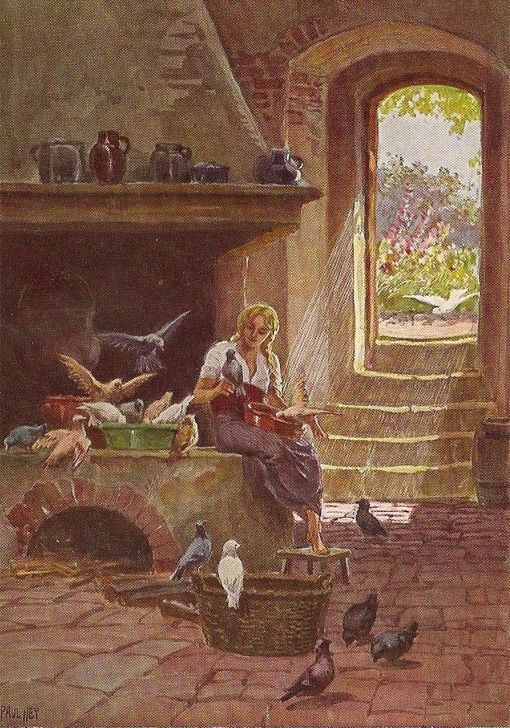 Image: Paul Hey (1867 – 1952)
Image: Paul Hey (1867 – 1952)And before half-an-hour was over it was all done, and they flew away. Then the maiden took the dishes to the stepmother, feeling joyful, and thinking that now she should go with them to the feast. But she said „All this is of no good to you. You cannot come with us, for you have no proper clothes, and cannot dance. You would put us to shame.“ Then she turned her back on poor Cinderella, and made haste to set out with her two proud daughters. And as there was no one left in the house, Cinderella went to her mother’s grave, under the hazel bush, and cried,
„Little tree, little tree, shake over me. That silver and gold may come down and cover me.“
Then the bird threw down a dress of gold and silver, and a pair of slippers embroidered with silk and silver. And in all haste she put on the dress and went to the festival. But her step-mother and sisters did not know her, and thought she must be a foreign princess, she looked so beautiful in her golden dress. Of Cinderella they never thought at all, and supposed that she was sitting at home, arid picking the lentils out of the ashes.
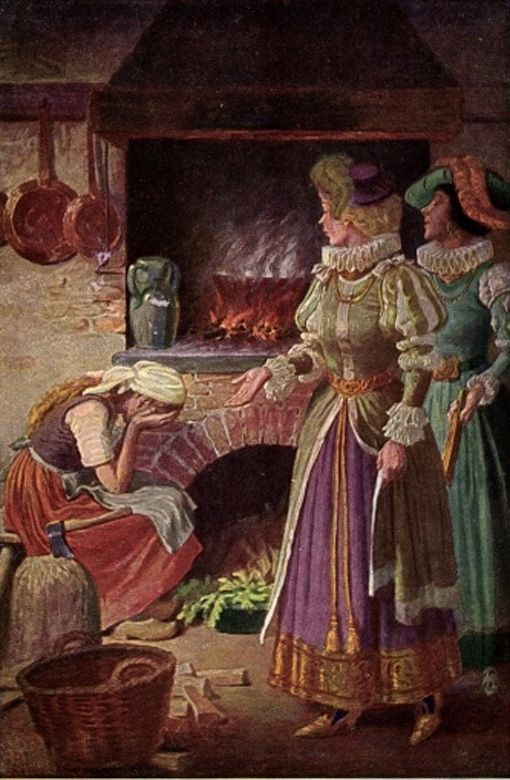 Image: Otto Kubel (1868 – 1951)
Image: Otto Kubel (1868 – 1951)The King’s son came to meet her, and took her by the hand and danced with her, and he refused to stand up with any one else, so that he might not be obliged to let go her hand. And when any one came to claim it he answered, „She is my partner.“ And when the evening came she wanted to go home, but the prince said he would go with her to take care of her, for he wanted to see where the beautiful maiden lived. But she escaped him, and jumped up into the pigeon-house. Then the prince waited until the father came, and told him the strange maiden had jumped into the pigeon-house.
The father thought to himself, „It cannot surely be Cinderella,“ and called for axes and hatchets, and had the pigeon-house cut down, but there was no one in it. And when they entered the house there sat Cinderella in her dirty clothes among the cinders, and a little oil-lamp burnt dimly in the chimney. For Cinderella had been very quick, and had jumped out of the pigeon-house again, and had run to the hazel bush. And there she had taken off her beautiful dress and had laid it on the grave, and the bird had carried it away again, and then she had put on her little gray kirtle again, and had sat down in. the kitchen among the cinders. The next day, when the festival began anew, and the parents and step-sisters had gone to it, Cinderella went to the hazel bush and cried,
„Little tree, little tree, shake over me. That silver and gold may come down and cover me.“
Then the bird cast down a still more splendid dress than on the day before. And when she appeared in it among the guests every one was astonished at her beauty. The prince had been waiting until she came, and he took her hand and danced with her alone. And when any one else came to invite her he said, „She is my partner.“ And when the evening came she wanted to go home, and the prince followed her, for he wanted to see to what house she belonged; but she broke away from him, and ran into the garden at the back of the house.
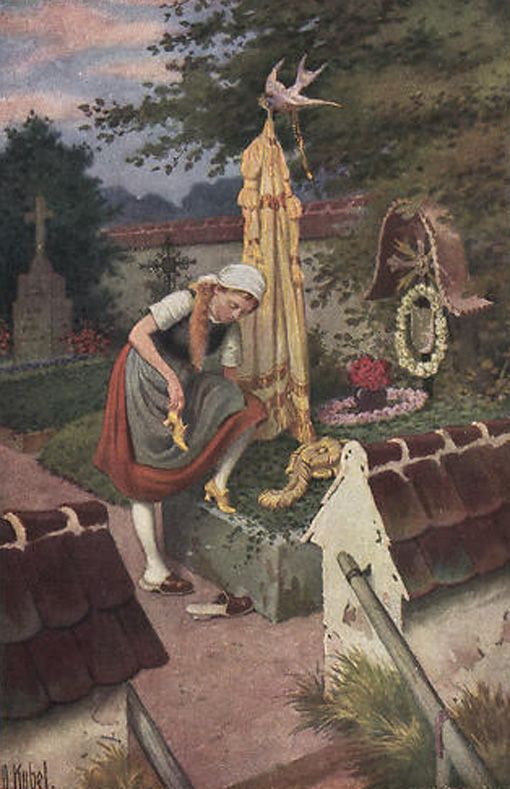 Image: Otto Kubel (1868 – 1951)
Image: Otto Kubel (1868 – 1951)There stood a fine large tree, bearing splendid pears. She leapt as lightly as a squirrel among the branches, and the prince did not know what had become of her. So he waited until the father came, and then he told him that the strange maiden had rushed from him, and that he thought she had gone up into the pear-tree. The father thought to himself, „It cannot surely be Cinderella,“ and called for an axe, and felled the tree, but there was no one in it. And when they went into the kitchen there sat Cinderella among the cinders, as usual, for she had got down the other side of the tree, and had taken back her beautiful clothes to the bird on the hazel bush, and had put on her old grey kirtle again. On the third day, when the parents and the step-children had set off, Cinderella went again to her mother’s grave, and said to the tree,
„Little tree, little tree, shake over me. That silver and gold may come down and cover me.“
Then the bird cast down a dress, the like of which had never been seen for splendour and brilliancy, and slippers that were of gold. And when she appeared in this dress at the feast nobody knew what to say for wonderment. The prince danced with her alone, and if any one else asked her he answered, „She is my partner.“ And when it was evening Cinderella wanted to go home, and the prince was about to go with her, when she ran past him so quickly that he could not follow her.
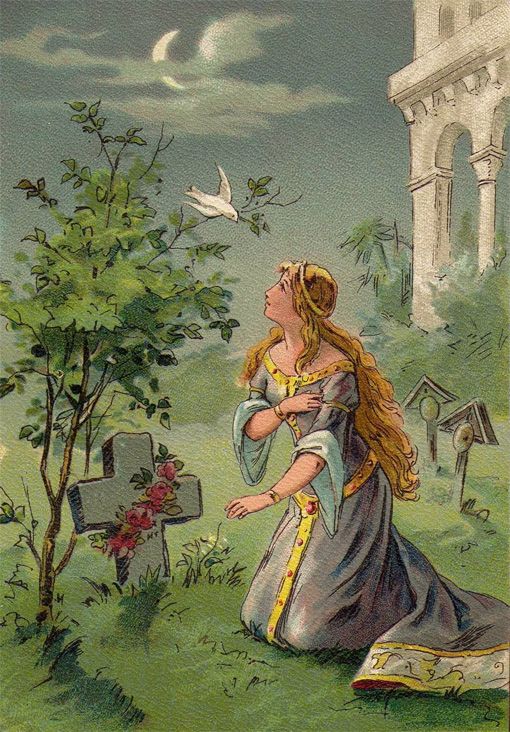 Image: Thekla Brauer (1856 – 1943)
Image: Thekla Brauer (1856 – 1943)But he had laid a plan, and had caused all the steps to be spread with pitch, so that as she rushed down them the left shoe of the maiden remained sticking in it. The prince picked it up, and saw that it was of gold, and very small and slender. The next morning he went to the father and told him that none should be his bride save the one whose foot the golden shoe should fit. Then the two sisters were very glad, because they had pretty feet. The eldest went to her room to try on the shoe, and her mother stood by.
 Image: Otto Kubel (1868 – 1951)
Image: Otto Kubel (1868 – 1951)But she could not get her great toe into it, for the shoe was too small. Then her mother handed her a knife, and said, „Cut the toe off, for when you are queen you will never have to go on foot.“ So the girl cut her toe off, squeezed her foot into the shoe, concealed the pain, and went down to the prince. Then he took her with him on his horse as his bride, and rode off. They had to pass by the grave, and there sat the two pigeons on the hazel bush, and cried,
„There they go, there they go! There is blood on her shoe. The shoe is too small. Not the right bride at all!“
Then the prince looked at her shoe, and saw the blood flowing. And he turned his horse round and took the false bride home again, saying she was not the right one, and that the other sister must try on the shoe. So she went into her room to do so, and got her toes comfortably in, but her heel was too large. Then her mother handed her the knife, saying, „Cut a piece off your heel. When you are queen you will never have to go on foot.“ So the girl cut a piece off her heel, and thrust her foot into the shoe, concealed the pain, and went down to the prince, who took his bride before him on his horse and rode off. When they passed by the hazel bush the two pigeons sat there and cried,
„There they go, there they go! There is blood on her shoe. The shoe is too small. Not the right bride at all!“
Then the prince looked at her foot, and saw how the blood was flowing from the shoe, and staining the white stocking. And he turned his horse round and brought the false bride home again. „This is not the right one,“ said he, „have you no other daughter?“
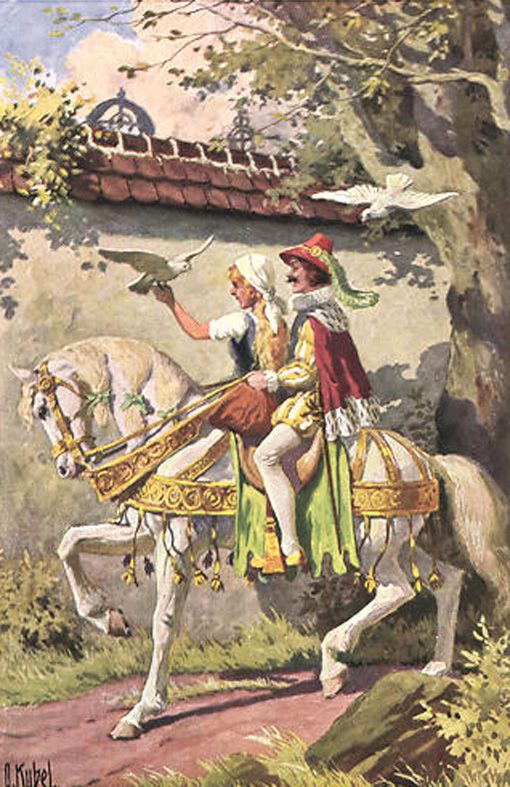 Image: Otto Kubel (1868 – 1951)
Image: Otto Kubel (1868 – 1951)„No,“ said the man, „only my dead wife left behind her a little stunted Cinderella. It is impossible that she can be the bride.“ But the King’s son ordered her to be sent for, but the mother said, „Oh no! she is much too dirty, I could not let her be seen.“ But he would have her fetched, and so Cinderella had to appear. First she washed her face and hands quite clean, and went in and curtseyed to the prince, who held out to her the golden shoe.
Then she sat down on a stool, drew her foot out of the heavy wooden shoe, and slipped it into the golden one, which fitted it perfectly. And when she stood up, and the prince looked in her face, he knew again the beautiful maiden that had danced with him, and he cried, „This is the right bride!“ The step-mother and the two sisters were thunderstruck, and grew pale with anger; but he put Cinderella before him on his horse and rode off. And as they passed the hazel bush, the two white pigeons cried,
„There they go, there they go! No blood on her shoe. The shoe’s not too small. The right bride is she after all.“
And when they had thus cried, they came flying after and perched on Cinderella’s shoulders, one on the right, the other on the left, and so remained. And when her wedding with the prince was appointed to be held the false sisters came, hoping to curry favour, and to take part in the festivities.
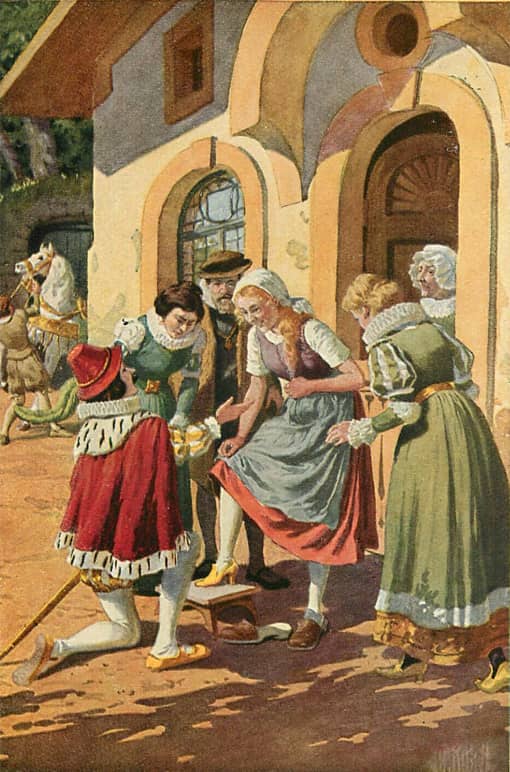 Image: Otto Kubel (1868 – 1951)
Image: Otto Kubel (1868 – 1951)So as the bridal procession went to the church, the eldest walked on the right side and the younger on the left, and the pigeons picked out an eye of each of them. And as they returned the elder was on the left side and the younger on the right, and the pigeons picked out the other eye of each of them. And so they were condemned to go blind for the rest of their days because of their wickedness and falsehood.
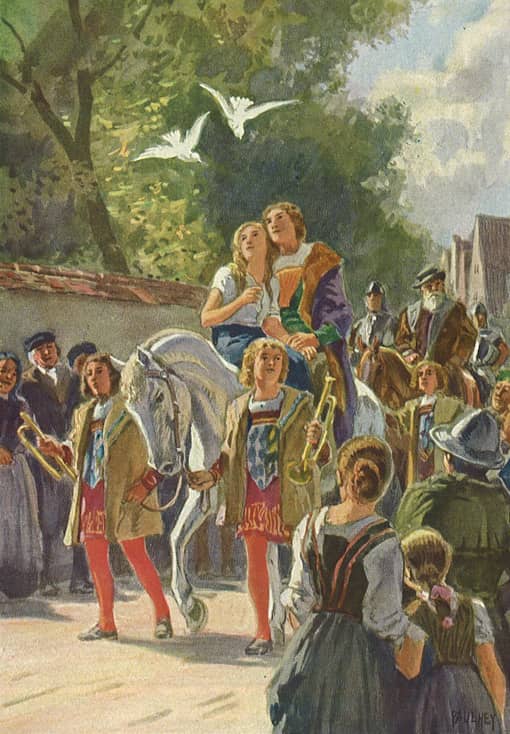 Image: Paul Hey (1867 – 1952)
Image: Paul Hey (1867 – 1952) Learn languages. Double-Tap on one word.Learn languages in context with Childstories.org and Deepl.com.
Learn languages. Double-Tap on one word.Learn languages in context with Childstories.org and Deepl.com.Backgrounds to fairy tale „Cinderella“
„Cinderella,“ also known as „Aschenputtel“ in German, is a popular fairy tale collected by the Brothers Grimm in their compilation „Grimm’s Fairy Tales“ (originally titled „Children’s and Household Tales“ or „Kinder- und Hausmärchen“ in German), first published in 1812. The tale is classified as ATU 510A (Cinderella and the Glass Slipper) in the Aarne-Thompson-Uther classification system, which categorizes folktales based on their narrative structure and elements.
The story of Cinderella can be traced back to various cultures and time periods, with versions of the tale appearing in ancient Greece, China, and Egypt. The Grimm brothers‘ version of the story is based on the oral storytelling traditions of Germany and other European regions. Jacob and Wilhelm Grimm were German academics and cultural researchers who aimed to preserve the cultural heritage and oral storytelling traditions of German-speaking areas by collecting and publishing numerous folk and fairy tales during the 19th century.
The first literary European version of the story was published in Italy by Giambattista Basile in his Pentamerone in 1634. The most widely known version in the English-speaking world was published in French by Charles Perrault in 1697. The story of Cinderella has influenced popular culture internationally, lending plot elements, allusions, and tropes to a wide variety of media. The name „Cinderella“ has come to mean someone whose attributes are unrecognized or someone who unexpectedly achieves recognition or success after a period of obscurity and neglect.
The Brothers Grimm’s version of „Cinderella“ is darker and more complex than the more widely known version by Charles Perrault, which includes the fairy godmother and the glass slipper. In the Grimm version, Cinderella receives help from a magical tree growing on her mother’s grave and the birds that visit her. The stepsisters in the Grimm tale also suffer gruesome consequences for their cruelty towards Cinderella.
„Cinderella“ reflects the values, beliefs, and societal norms of the time in which it was collected and published, touching on themes such as class, social mobility, and the transformative power of kindness and inner beauty. The story has persisted through the centuries due to its powerful message and relatable characters, making it one of the most well-known and beloved fairy tales of all time.
Interpretations to fairy tale „Cinderella“
Cinderella, also known as „The Little Glass Slipper,“ is a folk tale with thousands of variants worldwide. The story revolves around a young woman living in unfortunate circumstances that suddenly change to remarkable fortune, as she ascends to the throne via marriage. The earliest known variant of the Cinderella story is the tale of Rhodopis, which is about a Greek slave girl who marries the king of Egypt. The Brothers Grimm’s version of „Cinderella“ offers a variety of interpretations, reflecting the depth and complexity of their collected fairy tales. Some key interpretations of the story include:
Inner beauty and kindness: One of the central themes in „Cinderella“ is the importance of inner beauty and kindness. Cinderella is a character who is mistreated by her family, but her inherent goodness, patience, and humility ultimately lead her to a better life. This theme emphasizes that true beauty lies within and that kindness can triumph over cruelty.
Social mobility and class: The story of Cinderella touches on the issues of social mobility and class. Cinderella, who is initially relegated to a lower social status by her stepfamily, rises above her circumstances and finds happiness with the prince. This theme resonates with readers as it offers hope for change and the possibility of a better life, regardless of one’s background.
Justice and retribution: The Brothers Grimm’s version of „Cinderella“ features a darker, more vengeful aspect, with the stepsisters suffering gruesome consequences for their cruelty. This interpretation highlights the theme of justice, as the stepsisters are ultimately punished for their actions, while Cinderella is rewarded for her patience and goodness.
The role of fate and magic: Cinderella’s transformation and eventual happiness are aided by magical elements, such as the tree on her mother’s grave and the birds that help her. This theme suggests that fate and magic can intervene in human lives and help bring about positive change, especially for those who are kind and deserving.
The power of perseverance: Cinderella’s story demonstrates the importance of perseverance in the face of adversity. Despite the hardships and mistreatment she endures, Cinderella remains kind and hopeful, eventually achieving happiness and success. This theme serves as a reminder to readers that maintaining hope and resilience can lead to positive outcomes.
These interpretations of „Cinderella“ showcase the themes and messages that continue to resonate with readers today, illustrating the enduring appeal of the Brothers Grimm’s fairy tales.
Adaptions of the fairy tale „Cinderella“
„Cinderella“ is one of the most well-known and frequently adapted fairy tales, with numerous adaptations across various media. While many adaptations draw from Charles Perrault’s version, which includes the fairy godmother and the glass slipper, some adaptations are inspired by or incorporate elements from the Brothers Grimm’s version. The fairy tale of Cinderella, as told by the Brothers Grimm, has been adapted and reimagined countless times over the years in various forms of media, including literature, film, television, and stage productions. Here are some specific examples:
Films: „Aschenputtel“ (1955): A West German film adaptation of the Brothers Grimm’s „Cinderella“ that retains the darker elements and features the magical tree and birds instead of the fairy godmother. „Three Wishes for Cinderella“ (1973): A Czechoslovakian-East German adaptation that combines elements from the Brothers Grimm and Charles Perrault’s versions, presenting a more resourceful and assertive Cinderella. „Ever After“ (1998): This film starring Drew Barrymore is a retelling of the Cinderella story with a more feminist twist. It portrays Cinderella as a strong and independent woman who takes charge of her own destiny. „Rodgers and Hammerstein’s Cinderella“ (1997): This made-for-TV movie features a diverse cast and updates the story for a modern audience. It also includes several new songs written by Rodgers and Hammerstein.
Animation: „Cinderella“ (1950): Disney’s animated classic takes inspiration from Charles Perrault’s version but also includes some elements from the Brothers Grimm’s tale, such as the role of the birds in helping Cinderella. This animated film is one of the most well-known adaptations of the Cinderella story. It follows the basic plot of the original fairy tale, with some additional elements added for comedic effect. „Cinderella Monogatari“ (1996): A Japanese animated television series that offers a fresh take on the story, blending elements from both the Brothers Grimm and Charles Perrault’s versions.
Theater and Ballet: „Cendrillon“ (1899): A ballet by Jules Massenet that incorporates some elements from the Brothers Grimm’s version, such as the birds that assist Cinderella. „Into the Woods“ (1986): A Stephen Sondheim and James Lapine musical that weaves together various fairy tales, including the Brothers Grimm’s version of „Cinderella.“ „Into the Woods“ (1986): This musical by Stephen Sondheim and James Lapine features a mash-up of various fairy tales, including Cinderella. It explores the consequences of getting what you wish for and the importance of taking responsibility for your actions.
Literature: „Ella Enchanted“ (1997): A novel by Gail Carson Levine that reimagines the Cinderella story, incorporating elements from both the Brothers Grimm and Charles Perrault’s versions. The novel was later adapted into a film in 2004. „Cinder“ (2012): A novel by Marissa Meyer that retells the story of Cinderella in a futuristic, sci-fi setting, drawing inspiration from both the Brothers Grimm and Charles Perrault’s versions. „Cinder“ by Marissa Meyer (2012): This young adult novel reimagines Cinderella as a cyborg living in a futuristic society. The novel incorporates elements of science fiction and fantasy into the traditional fairy tale. „Ashpet: An Appalachian Tale“ by Joanne Compton and illustrated by Scott Cummins (2002): This children’s book retells the Cinderella story with an Appalachian setting and cultural influences.
These adaptations showcase the enduring appeal and versatility of the „Cinderella“ story, illustrating how the tale continues to inspire artists and captivate audiences across various media and genres. These are just a few examples of the many adaptations of the Cinderella story. The enduring popularity of the tale speaks to its timeless appeal and the ability of storytellers to adapt it to different times, places, and cultures.
Summary of the plot
In the Brothers Grimm version of „Cinderella,“ a young girl named Cinderella lives with her wicked stepmother and two stepsisters, who treat her cruelly and force her to work as their servant. Cinderella’s father is alive but does not protect her from the abuse. After her mother’s death, Cinderella plants a hazel tree on her grave and often visits it, seeking solace.
One day, the king organizes a festival, inviting all the young ladies in the kingdom to find a bride for his son, the prince. Cinderella’s stepsisters and stepmother attend, leaving her behind to finish her chores. Cinderella visits her mother’s grave and asks for help, and the tree provides her with a beautiful dress and shoes. Cinderella attends the festival, catching the prince’s attention, but she leaves before the end of the event to avoid being recognized. The festival continues for two more days, and each time Cinderella receives a new dress from the tree and dances with the prince. On the last night, the prince follows her as she leaves, hoping to find out who she is. Cinderella manages to escape but loses one of her golden shoes in the process.
The prince uses the golden shoe to find Cinderella, trying it on the feet of all the young ladies in the kingdom. When he reaches Cinderella’s house, the stepsisters try to force their feet into the shoe, even cutting off parts of their feet to make it fit. However, birds from the hazel tree alert the prince to their deception. Finally, Cinderella tries on the shoe, and it fits her perfectly. The prince recognizes Cinderella as the girl from the festival and marries her. The stepsisters attend the wedding, but the birds from the hazel tree punish them for their cruelty by pecking out their eyes. Cinderella, now the princess, lives happily ever after with her prince, while her stepmother and stepsisters receive their just punishment.
Informations for scientific analysis
Fairy tale statistics | Value |
|---|---|
| Number | KHM 21 |
| Aarne-Thompson-Uther-Index | ATU Typ 510A |
| Translations | DE, EN, EL, DA, ES, FR, PT, FI, HU, IT, JA, NL, PL, RO, RU, TR, VI, ZH |
| Readability Index by Björnsson | 27.9 |
| Flesch-Reading-Ease Index | 83.1 |
| Flesch–Kincaid Grade-Level | 6.5 |
| Gunning Fog Index | 8.8 |
| Coleman–Liau Index | 7.4 |
| SMOG Index | 7.9 |
| Automated Readability Index | 6.8 |
| Character Count | 14.086 |
| Letter Count | 10.746 |
| Sentence Count | 141 |
| Word Count | 2.723 |
| Average Words per Sentence | 19,31 |
| Words with more than 6 letters | 235 |
| Percentage of long words | 8.6% |
| Number of Syllables | 3.351 |
| Average Syllables per Word | 1,23 |
| Words with three Syllables | 92 |
| Percentage Words with three Syllables | 3.4% |


















I liked the story. This story was more violent than I thought it would be because it was a fairytale. And most fairytales aren’t this violent.it was cool how the doves kept on giving her whatever she asked for, like when she got the golden dress, and when she got the golden shoes.